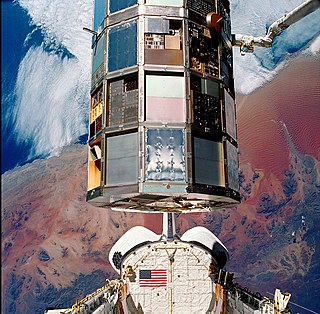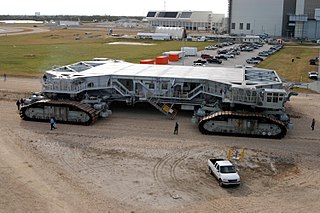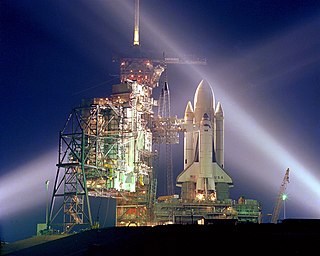Related Research Articles

STS-6 was the sixth NASA Space Shuttle mission and the maiden flight of the Space ShuttleChallenger. Launched from Kennedy Space Center on April 4, 1983, the mission deployed the first Tracking and Data Relay Satellite, TDRS-1, into orbit, before landing at Edwards Air Force Base on April 9, 1983. STS-6 was the first Space Shuttle mission during which a Extravehicular activity was conducted, and hence was the first in which the Extravehicular Mobility Unit (EMU) was used.

A launch pad is an above-ground facility from which a rocket-powered missile or space vehicle is vertically launched. The term launch pad can be used to describe just the central launch platform, or the entire complex. The entire complex will include a launch mount or launch platform to physically support the vehicle, a service structure with umbilicals, and the infrastructure required to provide propellants, cryogenic fluids, electrical power, communications, telemetry, rocket assembly, payload processing, storage facilities for propellants and gases, equipment, access roads, and drainage.

STS-32 was the 33rd mission of NASA's Space Shuttle program, and the ninth launch of Space ShuttleColumbia. Launched on January 9, 1990, it marked the first use of the Launch Complex 39A of Kennedy Space Center since 1986; it also marked the first use of Mobile Launcher Platform-3 (MLP-3) in the Space Shuttle program. STS-32 was, at the time, the longest shuttle mission yet conducted, with a duration of nearly 11 days. Before STS-32, the only mission of the same duration had been STS-9 in 1983. On January 20, 1990, STS-32 executed the third night landing of the shuttle program. STS-32 was also the first Shuttle mission of the 1990s.

Launch Complex 39A (LC-39A) is the first of Launch Complex 39's three launch pads, located at NASA's Kennedy Space Center in Merritt Island, Florida. The pad, along with Launch Complex 39B, was first constructed in the 1960s to accommodate the Saturn V launch vehicle, and has been used to support NASA crewed space flight missions, including the historic Apollo 11 moon landing and the Space Shuttle. The site is currently leased by SpaceX and supports launches of the Falcon 9 and Falcon Heavy rockets.

The crawler-transporters, formally known as the Missile Crawler Transporter Facilities, are a pair of tracked vehicles used to transport launch vehicles from NASA's Vehicle Assembly Building (VAB) along the Crawlerway to Launch Complex 39. They were originally used to transport the Saturn IB and Saturn V rockets during the Apollo, Skylab and Apollo–Soyuz programs. They were then used to transport Space Shuttles from 1981 to 2011. The crawler-transporters carry vehicles on the mobile launcher platforms used by NASA, and after each launch return to the pad to take the platform back to the VAB.

Launch Complex 39 (LC-39) is a rocket launch site at the John F. Kennedy Space Center on Merritt Island in Florida, United States. The site and its collection of facilities were originally built as the Apollo program's "Moonport" and later modified for the Space Shuttle program.

STS-119 was a Space Shuttle mission to the International Space Station (ISS) which was flown by Space Shuttle Discovery during March 2009. It delivered and assembled the fourth starboard Integrated Truss Segment (S6), and the fourth set of solar arrays and batteries to the station. The launch took place on March 15, 2009, at 19:43 EDT. Discovery successfully landed on March 28, 2009, at 15:13 pm EDT.
Space Shuttle missions designated STS-3xx were rescue missions which would have been mounted to rescue the crew of a Space Shuttle if their vehicle was damaged and deemed unable to make a successful reentry. Such a mission would have been flown if Mission Control determined that the heat shielding tiles and reinforced carbon-carbon panels of a currently flying orbiter were damaged beyond the repair capabilities of the available on-orbit repair methods. These missions were also referred to as Launch on Demand (LOD) and Contingency Shuttle Crew Support. The program was initiated following loss of Space Shuttle Columbia in 2003. No mission of this type was launched during the Space Shuttle program.

A mobile launcher platform (MLP), also known as mobile launch platform, is a structure used to support a large multistage space vehicle which is assembled (stacked) vertically in an integration facility and then transported by a crawler-transporter (CT) to a launch pad. This becomes the support structure for launch.

Gimbaled thrust is the system of thrust vectoring used in most rockets, including the Space Shuttle, the Saturn V lunar rockets, and the Falcon 9.

The Crawlerway is a 130-foot-wide (40 m) double pathway at the Kennedy Space Center in Florida. It runs between the Vehicle Assembly Building and the two launch pads at Launch Complex 39. It has a length of 3.4 and 4.2 miles to Pad 39A and Pad 39B, respectively. A seven-foot (2 m) bed of stones lies beneath a layer of asphalt and a surface made of Alabama river rocks.

STS-133 was the 133rd mission in NASA's Space Shuttle program; during the mission, Space Shuttle Discovery docked with the International Space Station. It was Discovery's 39th and final mission. The mission launched on February 24, 2011, and landed on March 9, 2011. The crew consisted of six American astronauts, all of whom had been on prior spaceflights, headed by Commander Steven Lindsey. The crew joined the long-duration six person crew of Expedition 26, who were already aboard the space station. About a month before lift-off, one of the original crew members, Tim Kopra, was injured in a bicycle accident. He was replaced by Stephen Bowen.

STS-123 was a Space Shuttle mission to the International Space Station (ISS) which was flown by Space Shuttle Endeavour. STS-123 was the 1J/A ISS assembly mission. The original launch target date was February 14, 2008, but after the delay of STS-122, the shuttle was launched on March 11, 2008. It was the twenty-fifth shuttle mission to visit the ISS, and delivered the first module of the Japanese laboratory, Japanese Experiment Module (Kibō), and the Canadian Special Purpose Dexterous Manipulator, (SPDM) Dextre robotics system to the station. The mission duration was 15 days and 18 hours, and it was the first mission to fully utilize the Station-to-Shuttle Power Transfer System (SSPTS), allowing space station power to augment the shuttle power systems. The mission set a record for a shuttle's longest stay at the ISS.

STS-124 was a Space Shuttle mission, flown by Space Shuttle Discovery to the International Space Station. Discovery launched on May 31, 2008, at 17:02 EDT, moved from an earlier scheduled launch date of May 25, 2008, and landed safely at the Kennedy Space Center's Shuttle Landing Facility, at 11:15 EDT on June 14, 2008. Its objective was to deliver the largest module of the space station – Kibō, the Japanese Experiment Module pressurized section. The mission is also referred to as ISS-1J by the ISS program.

Launch Complex 39B (LC-39B) is the second of Launch Complex 39's three launch pads, located at NASA's Kennedy Space Center in Merritt Island, Florida. The pad, along with Launch Complex 39A, was first designed for the Saturn V launch vehicle, which at the time was the United States' most powerful rocket. Typically used to launch NASA's crewed spaceflight missions since the late 1960s, the pad is currently configured for use by the agency's Space Launch System rocket, a Shuttle-derived launch vehicle which is currently used in the Artemis program and subsequent Moon to Mars campaigns. The pad had also been leased by NASA to aerospace company Northrop Grumman, for use as a launch site for their Shuttle-derived OmegA launch vehicle, for National Security Space Launch flights and commercial launches, before the OmegA program was cancelled.

STS-400 was the Space Shuttle contingency support flight that would have been launched using Space ShuttleEndeavour if a major problem occurred on Space ShuttleAtlantis during STS-125, the final Hubble Space Telescope servicing mission.

The retirement of NASA's Space Shuttle fleet took place from March to July 2011. Discovery was the first of the three active Space Shuttles to be retired, completing its final mission on March 9, 2011; Endeavour did so on June 1. The final shuttle mission was completed with the landing of Atlantis on July 21, 2011, closing the 30-year Space Shuttle program.
Sites for launching large rockets are often equipped with a sound suppression system to absorb or deflect acoustic energy generated during a rocket launch. As engine exhaust gasses exceed the speed of sound, they collide with the ambient air and shockwaves are created, with noise levels approaching 200 db. This energy can be reflected by the launch platform and pad surfaces, and could potentially cause damage to the launch vehicle, payload, and crew. For instance, the maximum admissible overall sound power level (OASPL) for payload integrity is approximately 145 db. Sound is dissipated by huge volumes of water distributed across the launch pad and launch platform during liftoff.

Hail Columbia is a 1982 American IMAX documentary film about NASA's Space Shuttle program, particularly the first Space Shuttle, Columbia. The film was directed by Graeme Ferguson.

A flame deflector, flame diverter or flame trench is a structure or device designed to redirect or disperse the flame, heat, and exhaust gases produced by rocket engines or other propulsion systems. The amount of thrust generated by a rocket launch, along with the sound it produces during liftoff, can damage the launchpad and service structure, as well as the launch vehicle. The primary goal of the diverter is to prevent the flame from causing damage to equipment, infrastructure, or the surrounding environment. Flame diverters can be found at rocket launch sites and test stands where large volumes of exhaust gases are expelled during engine testing or vehicle launch.
References
- ↑ "Fondu Fyre". Trademark Electronic Search System (TESS). United States Patent and Trademark Office. Retrieved 17 October 2021.
- ↑ "NASA - Spray-on Layer to Protect Flame Trench". NASA. Retrieved 22 November 2022.